Editor’s Note: This text course is an edited transcript of a live webinar. Download supplemental course materials.
This course is an introduction to the Cheer family of products. Cheer is a well-balanced line-up of Sonic products featuring impressive sound quality statistics. Anyone who has ever fit a Sonic product knows the natural component of sound is something that we hold near and dear to our hearts. The following is an introductory video of Cheer.
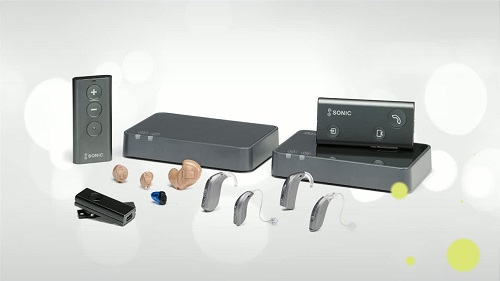
Sound
Today, we are going to talk about all of the things that are important to Cheer. First and foremost is the sound. Natural sound begins with a sound processor that is engineered for premium quality. We have an industry-acclaimed system. We hear from users and professionals every day of the incredible benefit that our products are giving them. I cannot fix hearing. However, I can do an incredible job of helping people hear the way they used to hear because the sound in these products is very natural.
To have a natural sound quality, we deploy four systems in the Cheer line-up. They are Speech Variable Processing (SVP), Adaptive Feedback Canceller, Best Fit Fast (2nd edition or Sound Enhancement), and Frequency Transfer. Let’s go over these features.
Speech Variable Processing
In SVP, we have three important components: speech, speed, and preserve. Speech is complex and dynamic. That is how our brain is able to determine the difference between a vowel and a consonant and what is speech and what is noise. Speed is also very important. Amplification must be applied appropriately to be correct. If we cannot apply the appropriate amount of amplification, that patient is going to be over or under amplified. Speed is very important to providing the correct amplification. Last is preservation of the frequency contrast. If you cannot maintain frequency contrast, you will not have clarity. Many people with hearing loss say that everything sounds mumbled. How we approach frequency contrast to take that exact replica and preserve all the nuances of speech is critical to the success that we have had with our instruments.
A word about speech. Individual sounds are long and short. Think about a vowel versus a consonant. Those amplitude changes are quick and dramatic. The healthy cochlea is going to process speech naturally. Therefore, processing systems require sophisticated technology to replicate speech accurately.
Figure 1 is our tagline, “Every Day Sounds Better.” In this picture, you can see that the /a/ has quite a bit of energy versus the /s/, which has a very low amplitude. That /s/, however, is such an important consonant and one which our hearing aid people often miss. As you can see, you have to have a system that can analyze everything in its entirety.
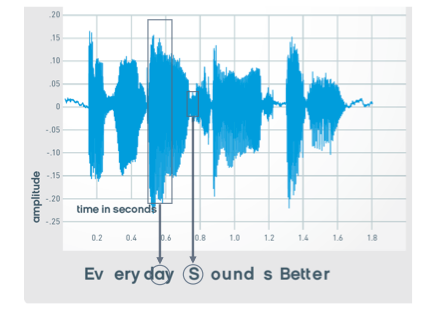
Figure 1. “Everyday sounds better.” Phonemic comparison of /a/ versus /s/.
We are introducing a new component to SVP in our Cheer platform. We have focused on phonemes for quite some time with our SVP platform. Quickly and accurately, we measure the incoming signal and apply the gain appropriately, especially for loud and soft sounds. The benefit with SVP using Phoneme Focus is that it is going to make sound clear and natural in a variety of listening situations.
Envelope Focus
If you have fit our Celebrate product, Phoneme Focus is the SVP that you have used. It is an incredibly rapid and fast system that is going to attack and release that signal as needed. For the vast majority of the population, this approach is needed to make things sound clear and natural. We are excited to present a brand new variety of SVP in Cheer called Envelope Focus. It is designed for certain populations with criteria for age, high-frequency hearing thresholds and air-bone gap information.
We enhance the slower speech envelope components of the signal, so the consonants will remain softer compared to the adjacent vowels, therefore giving a bigger contrast. For some people, this results in better speech understanding. It is going to make sound clear and natural in a variety of listening situations for some populations. For patients who are used to technology with a slower attack and release and who have some processing situations, Envelope Focus may be a great solution for your patient.
Here is an animation to show how Envelope Focus is working in the instrument.
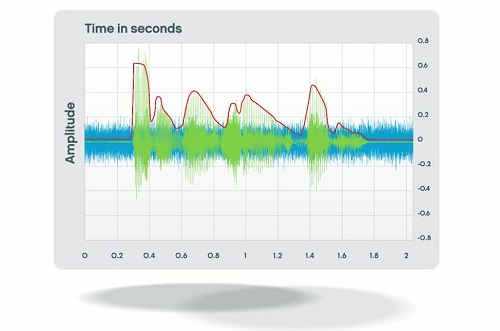
The ExpressFit 2015.2 software will select whether it uses Envelope or Phoneme Focus based on the patient’s age, their high-frequency thresholds, and air-bone gap, but we still strongly believe that as clinicians, you are the experts and have the flexibility to override that decision as you see fit for your patient. At Sonic, we strongly believe in giving clinicians flexibility to make the adjustments you need as the expert. You will always see that from us as an organization.
Importance of Contrast
As mentioned previously, the healthy cochlea preserves the natural level differences across frequencies of each phoneme, which is what we call frequency contrast. We also know that it is critical for speech clarity. If you do not have a system that can maintain these differences, you will have patients telling you that things sound muddled. Some even say that they are doing better without the hearing aids. That is the last thing we want to hear as hearing health professionals.
How we approach frequency contrast is very important, and that is something that has been successful in Sonic products. We take great care to preserve the peak-to-valley differences within each phoneme to replicate. We do not take little snippets and divvy things up. We look at the entire speech spectrum to make sure we are capturing every aspect of that phoneme to attack it correctly.
Noise and Feedback Management
Sonic’s feedback cancellation system uses an adaptive phase canceller but also has a feedback monitor. That is what makes the system unique. The feedback monitor removes feedback signals before they are even noticeable. The incoming signal hits the instrument and we instantly memorize the signal characteristics. At that moment, the system says, “Have you been here before?” If that signal has been in the system in the last 5 msec, it is most likely feedback. We will route that input through, invert it, and send it back out.
We have gone from having feedback complaints to zero feedback complaints. This feedback canceller was a game changer. We are giving our patients the opportunity for squeal-free, easy listening. Whether you are wearing a hat or hugging people, these hearing instruments are fantastic in the behind-the-ear (BTE), receiver-in-the-ear (RITE) and custom instruments.
Fitting Rationale
Best Fit Fast Speech Enhancement (SE) is our proprietary fitting rationale available in ExpressFit 2015.2. It is designed to quickly achieve a good, fast-fit result, emphasizing speech intelligibility. It is perfect for patients who want a little more gain at the first fit. They want to hear that amplification. This is an excellent opportunity to give patients just that. If you have any questions specifically about this, you can call us and we will walk you through our proprietary fitting rationale.
Frequency Transfer
Frequency Transfer is a popular topic in various blogs and articles. I am pleased to share with you that Cheer 60 has an option of frequency transfer. At Sonic, we copy and compress the high-frequency input and then transfer it to the lower-frequency region where there is better residual hearing. The benefit here is simple. We will improve access, and therefore audibility, of speech cues, but keep the full bandwidth intact for seamless natural sound.
We believe in our 4S Foundation, and the first S is sound that is natural. In everything we do, we are ensuring that our patients are experiencing a natural sound quality. Here is a short video.
As the video commented, you can have a lot of flexibility within ExpressFit. You can pick the region to which you want to make that transfer. You can also set the aggressiveness of the transfer. There are different settings from a strength perspective. I want to reiterate that it is not a default program. We make the selection based on the patient’s audiogram. The algorithm may suggest that the patient could benefit based on their thresholds, but as the clinician, you are the expert and can make that decision.
The other aspect that is important is the compression level within the bandwidth we want to preserve. We do not to compress the bandwidth so much that we lose the natural component of speech. We are going to preserve that signal as best we can. Frequency Transfer is available in Celebrate as well as Journey, which is our superpower BTE instrument, and now in Cheer 60. We have had positive reports from patients who tried other products with frequency lowering, and patients love Frequency Transfer. I guarantee you will have a happy patient saying “I can hear those signals again.”
Speech Understanding in Noise
Speech understanding in noise is the second S of our 4S Foundation. When it comes to hearing, all sounds are not created equal. Cheer instruments deploy adaptive directionality, wind noise reduction, soft noise reduction, and Speech Priority Noise Reduction.
Adaptive Directionality
Our products quickly analyze the incoming signal and determine the location of the loudest sound in the region. It then selects the best polar response independently in each region to improve the signal-to-noise ratio. There are four different regions. I like to call them low, low-mids, mid-highs, and highs. Each region is going to behave independently. This adaptive directionality is available in the Cheer 60 and the Cheer 40, and it is a very competitive system The overall patient report from the Cheer products is that they are able to hear what was going on at dinner in a busy restaurant.
Wind Noise Reduction
If you have ever blown into a hearing aid, you know the sound you hear is terrible. Wind is awful in a hearing instrument. Our wind noise reduction system is going to monitor for uncorrelated noise. It is inconsistent. Behind the scenes, we are going to ensure that that patient has relief from loud, distracting wind noise.
Soft Noise Reduction
For a long time, no one understood what expansion did. Expansion is the opposite of compression. We use expansion to manage the gain from low level sounds while maintaining the gain for speech. We refuse to sacrifice how that patient is going to handle speech and the gain that is needed for speech. Low-level environmental sounds are pervasive, and normal hearing listeners hear them, too, but our brain knows that they are not important or alerting signals, so it automatically ignores them. When you have a new hearing aid user who has not heard these sounds for a long time, what are they going to do? They are going to fixate on that signal. Sonic instruments keep those low-level signals at bay. The last thing we want is our patients bothered by noise.
Speech Priority Noise Reduction
Here at Sonic we believe in straight talk. With Speech Priority Noise Reduction, we are going to give speech the priority and reduce the noise. We monitor the input and determine the modulation fingerprint of the signal. Highly modulated signals are preserved because they are speech signals. Steady-state noise is attenuated. We provide comfort and preserve intelligibility of the speech signal. When we layer on speech priority noise reduction to SVP, the hearing instrument is going to know what is speech and what is noise. We are able to be so successful because of how fast our engine is running, regardless of whether you are using Envelope Focus or Phoneme Focus.
Competitive systems often cannot do this. Unfortunately, everything gets attenuated, including the speech signal. If we are attenuating the speech signal for the patient who came to you saying they cannot hear in noise, what are doing? We are not offering them a lot of help. Speech Priority Noise Reduction is successful and it is something to be excited about in the Cheer level technologies.
Simplicity
Our third 3 S is simplicity. Life is full of excitement, and Cheer is ready for the adventure. Simplicity is in everything we do here at Sonic, but simplicity does not mean simple. In my head, simplicity means sophistication. We want to be simple to work with as an organization. We want to provide you clear, out of the box, simple solutions for your patients.
In Cheer, we have a universal environment. We have data learning, binaural coordination and wireless connectivity. All of these things working together will make your day easy. You will not be frustrated with the Cheer product and features. Simplicity is in everything we do with true sophistication.
Universal Environment
We constantly monitor the environment for sound level, presence of speech, frequency content and harmonics. Speech is king in everything we do, whether it is speech or noise or wind, and the hearing instrument needs to know how to respond accordingly. The nice thing is that the patient does not have to do anything. Our devices ship with the universal programmer, as the default in P1. Our patients love the universal program, and audiologists do not have to be creative and create this one program to do a variety of things in all different scenarios. By doing this so sophisticatedly in the software, it is a breeze.
Data Learning
Data learning is a Cheer 60 exclusive feature. Data learning is also available in the Celebrate 80 as well as our Journey 80 technology. It is simple, but very smart. Data learning will adapt the default amplification setting over time to match what the patient is doing. This will record how the patient is adjusting the volume in a 20-hour time period, and where they are using a Sound Gate (our remote streamer) or possibly our remote control (RC-N). After a 20-hour segment, the hearing instrument will remember if the user is always turning up the volume control, and at the next power cycle or program change, it will up the overall amplification to match the patient’s preferences. The maximum plus or minus swing is + or – 6 dB. Would I put this on every new user? Probably not. If they are a previous user who knows how to manipulate a volume control, I would activate this.
We live in Minnesota and have many snowbirds who like to head south during the winter. If they are wearing the hearing instruments and will not to be able to come in for fine-tuning, data learning is an excellent feature for them. It will give them their own manipulator. Again, if the patient is turning it up and up over a 20-hour period, it will reset with a 2 dB increase. If the patient is turning it down and down, it will bring it down 2 dB. It adjusts the default amplification. When that patient comes back for their next programming session, you will get a message in ExpressFit that says learning has occurred. Do you want to import the new settings or reject the settings? As the clinician, you are the expert and can evaluate the changes. Data learning is available in the 60-level technology.
The Balance of Binaural
Binaural synchronization handles program and volume control changes. When you change one instrument on the controller, it will change the other instrument. We also have the non-telephone ear control which is available in the 60-level technology. It will automatically recognize the non-telephone ear, and you can set up ExpressFit to reduce the gain in the non-telephone ear or mute it.
It does reduce the environmental noise distraction. For people who are wearing a hearing aid, it will increase the perception of volume from the telephone. That it is available in the Cheer 60 technology.
Connectivity
We offer convenience of wireless connectivity at an incredible value. Sound Gate 3 is our hub of connectivity to accessories. It connects to any Bluetooth enabled product. It has incredible battery life, program and volume changes, and it works with our SoundLink app. Sound Gate 3 has functionality and can communicate with Cheer 60 and Cheer 40 wireless models. The Sound Gate mic is a companion microphone that you can clip on your shirt. It is a personal private connection with Sound Gate 3 that is lightweight and incredibly discreet. It can be used in a meeting or house of worship of a variety of places.
The TV Adapter 2 is available in the Cheer 60 and 40. The TV Adapter communicates with the Sound Gate and directly streams to the Cheer instruments without a delay. The Phone Adapter 2 is for those people who still have landline phones. The Phone Adapter 2 provides a binaural wireless link making non-mobile phone calls vibrant and clear. Because the Phone Adapter 2 is still communicating with the Sound Gate, it is available in the Cheer 60 and Cheer 40 wireless models.
Our SoundLink app is available for iPhone and Android platforms. The features on the app itself show different Bluetooth sources in range. You can view battery life of the Sound Gate, change the volume and the program, and change the listening source. At dinner the other night, I looked over at another table and I commented that all of the people were on their phones. Earlier in the day, I had been telling my husband about the cool features of this app. My husband wondered if anyone at that other table was just adjusting their hearing aids. Most people have smart phones these days and no one would think anything of someone looking at their phone; it is a robust and inconspicuous feature available for our patients. This works with the Cheer 60 and Cheer 40 technology through the Sound Gate.
Remote Control
The RC-N is our newest remote control. Its basic functionality is for patients who are not interested in Bluetooth. It is available all the way down to the 20-level technology. You can increase and decrease the volume and change the program. It is very lightweight and much smaller than our old remote control. The buttons are large for dexterity issues. This will also work with the 60 and 40 level technology, but this is your wireless option at the Cheer 20 technology level.
Hassle-Free Fittings
The FittingLINK will work with any of the Cheer products and will increase patient comfort during a fitting, wirelessly. They are no cables to weigh them down. We also offer Real Ear Fit in our ExpressFit fitting system, incorporating verification systems into ExpressFit 2015.2.
Style
With so many styles and tech levels, you will find features to meet a variety of your hearing needs. This is the final S of our 4S Foundation- Style that stands out. We have four new models available in the Cheer offering, including the miniRITE, the Nano BTE, Power BTE and Compact Power Plus. Figure 2 shows the six available colors: beige, taupe, brown, grey, dark grey, and black. The Nano and mini RITE are slim designs that are very discreet for our patients. Our new Power BTE and Compact Power Plus are for more severe needs.
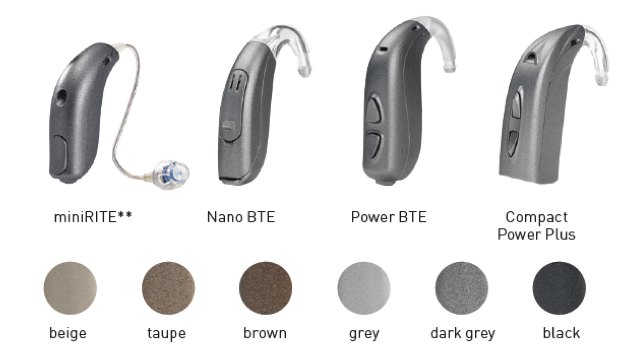
Figure 2. Color offerings of Cheer.
MiniFIT System
The MiniFIT system fitting kit is available for all of our products. The domes that work for our RITE products, like the Cheer miniRITE, are the exact same domes that will work for our thin tube products. The miniFIT system is a complete system that will keep all of your Cheer acoustic accessories together.
MiniRITEs
The miniRITE (Figure 3) is available in the Cheer 60 and Cheer 40. This sleek and attractive design comes with a 312 battery and is available in the Celebrate 100 and Celebrate 80. We have three receiver options, new domes, custom molds and six color options in the miniRITE.
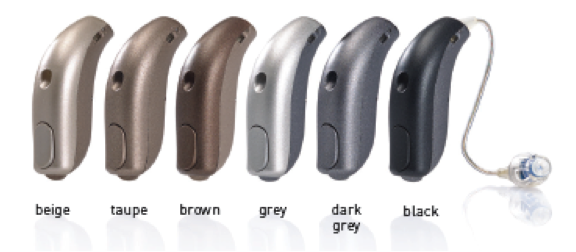
Figure 3. miniRTE.
There are three different speaker options, the 60, 85, and 100. The number delineates the maximum fitting range we have for that product. In the 85, there is a 116 dB SPL peak 90 with 55 dB full-on gain. The Nano BTE (Figure 4) has a 122/49 dB matrix in a sleek design.
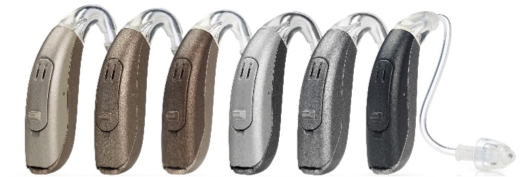
Figure 4. Nano BTE.
The new Power BTE (Figure 5) has a new case design. This is also available in our Celebrate technology. It uses the miniFIT system, which can be fit with an ear hook or a thin tube. This is a sleek design with a size 13 battery. It is the power patients require with excellent tactile controls. This has a 134/68 dB matrix.
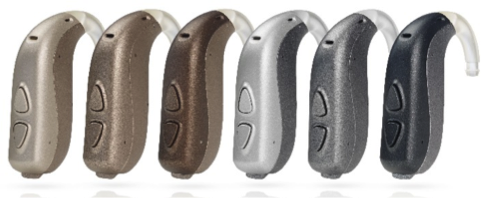
Figure 5. Power BTE.
The Compact Power Plus (Figure 6) has a 132/71 dB matrix. This device can also be fit with an ear hook or thin tube configuration.

Figure 6. Compact Power Plus.
In the Ear (ITE)
The invisible-in-the-canal (IICs) was added to the ITE models. Sonic has always been known for its excellence in the custom arena. They are fully customizable to the needs of your patient. We have hydrophobic coating protecting both the microphone and receiver, whether it is the Pro Wax or the T-caps or O-caps. It will repel any type of debris.
Figure 7 shows a comparison of custom acoustic performance in the new models versus our Charm products. With the launch of Cheer, we now offer four new models: the completely-in-the-canal (CIC) wireless, the CIC Power wireless, the in-the-canal (ITC), and the ITC wireless. The yellow arrows indicate an increase in power over previous models. We rely on you to tell us what we can do to make your life easier, and one of the things we heard was that you need more power. In the ITC PDW, the ITED, and ITE PDW offer more power relative to the Charm instruments.
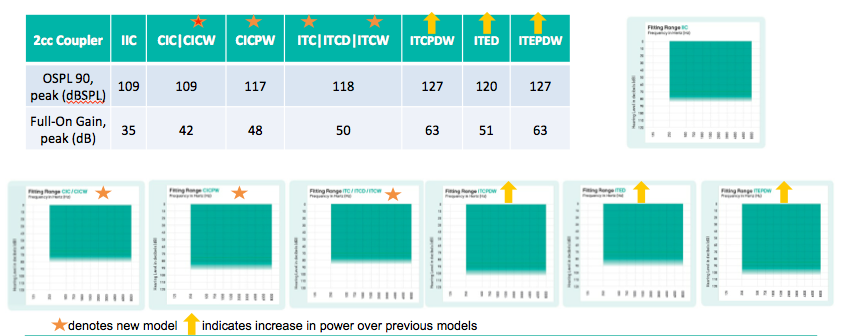
Figure 7. Acoustic performance in the custom Cheer products versus previous custom Charm products. Note: star denotes a new model, and yellow arrow indicates power increase over previous models.
Summary
In Cheer 60, 40 and 20, we offer Phoneme and Envelope Focus. Frequency transfer is available in the Cheer 60-level technology. Wind noise reduction is available in Cheer 60 and 40. Speech Priority Noise Reduction is available in 60, 40, and even the 20-level technology. Many companies who have entry-level technology may put a different sound processor in it. We put the exact same processor in the 20-level technology as we do the 100. It is our commitment to you that we are putting our best foot forward with every instrument that we produce.
Directionality with Adaptive Directionality is available in 60, 40, and 20-level technology, and we have fixed directional as well as omnidirectional capabilities. For binaural coordination, the non-telephone ear control with the auto telephone feature is available in the Cheer 60. However, everything else from a coordination aspect is available in the 60, 40 and 20 levels.
There are different environments with environment-based programming. There are 13 program options in the 60 level, 11 in the 40 level, and five in the 20 level. All wireless products can be programmed with the FittingLINK. All of the instruments have the Real Ear Fit within ExpressFit 2015.2. Startup delay, push button mute, all of the indicators, including wireless connectivity, go down into the 20 level of product.
Questions and Answers
Can you review which receivers are available for the Cheer miniRITE?
The Cheer miniRITE is available in the 60 and 40 levels of technology, but you have a 60, 85, and 100 dB speaker option. You can fit to your patient and their hearing loss needs.
Cite this Content as:
Reichert, E. (2016, January). Everybody on your feet! Introducing Cheer! AudiologyOnline, Article 16200. Retrieved from https://www.audiologyonline.com.


